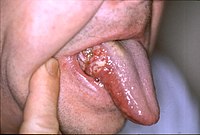
Photo from wikipedia
Transcription factor high‐mobility group box‐containing protein 1 (HBP1) may function as a tumor suppressor in various types of cancer. In a previous study, we demonstrated that HBP1 suppressed cell invasion… Click to show full abstract
Transcription factor high‐mobility group box‐containing protein 1 (HBP1) may function as a tumor suppressor in various types of cancer. In a previous study, we demonstrated that HBP1 suppressed cell invasion in oral cancer. To further understand the underlying mechanism, the current study is aimed at investigating how HBP1 exerts its antimetastatic potential in oral cancer. In a cell model, ectopic expression of HBP1 potently suppressed epithelial–mesenchymal transition, cellular migration, and invasion; conversely, HBP1 knockdown promoted these malignant phenotypes. The matrix metalloproteinase (MMP) family is highly implicated in tumor metastasis. Therefore, we examined the effect of HBP1 on the activation of the MMP members, MMP‐2, ‐9, and ‐13 that are highly associated with the aggressiveness of oral cancer. Ectopic expression of HBP1 resulted in a mild reduction in the expression and activity of MMP‐2 and ‐9, yet it had a potent inhibitory effect on MMP‐13. In contrast, HBP1 knockdown strongly enhanced the activation of MMP‐13. Further, we demonstrated that MMP‐13 is a target of HBP1 transcription repression as evidenced by the identification of an HBP1 binding site in the cis proximal region of the MMP‐13 promoter. More important, MMP‐13 knockdown significantly alleviated HBP1 small interfering RNA‐mediated promotion in cell invasion. Analysis of oral tumor specimens revealed that the low HBP1 (<0.3‐fold)/high MMP‐13 (>3‐fold) status was associated with metastatic potential. All told, our study provides evidence supporting the idea that the HBP1–MMP‐13 axis is a key regulator of the aggressiveness in oral cancer.
Journal Title: Journal of Cellular Physiology
Year Published: 2019
Link to full text (if available)
Share on Social Media: Sign Up to like & get
recommendations!